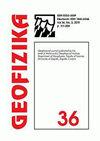Improvement of 1D geoelectric sounding by narrowing the equivalence range and identification, quantification and reduction of lateral effects using the tri-potential technique
IF 1.1
4区 地球科学
Q4 GEOCHEMISTRY & GEOPHYSICS
引用次数: 0
Abstract
Apparent resistivity data from the Offset-Wenner array (Zemun, Serbia), the square array (Bogatić and Golubac, Serbia) and the Wenner tri-potential technique (Vrdnik, Serbia), were used to detect, measure, and reduce lateral effects in 1D inversion. Forward and inverse modelling with the Wenner α, β and γ arrays determined that the Wenner β array provided the most accurate estimate of the first-and second-layer resistivity, while the Wenner γ array provided the most accurate estimate of the high resistivity substratum. The survey on the Zemun loess plateau revealed that if the lateral index of inhomogeneity (LII) is low, the 1D interpretation of both Wenner arrays is justifiable. In addition, the averaging of resistances will result in an apparent resistivity curve that is devoid of lateral effects resulting from near-surface inhomogeneities. As demonstrated by the Vrdnik example, 1D inversion is inadequate when the values of LII and processing covariance (PC) are high. The survey in Golubac was conducted using the square array, which produced lower PC values than collinear arrays. Therefore, the quality of the averaged sounding curve was higher. Also, the interpolated values of the Offset Wenner array displayed reasonable accuracy, while the extrapolated values were inadequate when a low resistivity substratum was present.缩小等效范围,利用三电位技术识别、量化和减少侧向效应,改进一维地电测深
利用Offset-Wenner阵列(Zemun,塞尔维亚)、方阵(bogatiki和Golubac,塞尔维亚)和Wenner三电位技术(Vrdnik,塞尔维亚)的视电阻率数据来探测、测量和减少一维反演中的横向影响。利用Wenner α、β和γ阵列进行正反模拟,结果表明Wenner β阵列提供了最准确的第一层和第二层电阻率估计,而Wenner γ阵列提供了最准确的高电阻率基底估计。在泽门黄土高原的调查表明,如果横向不均匀性指数(LII)较低,两种温纳阵列的一维解释都是合理的。此外,电阻的平均将得到一条视电阻率曲线,该曲线没有近地表不均匀性造成的侧向影响。如Vrdnik的例子所示,当LII和处理协方差(PC)的值很高时,一维反演是不充分的。在Golubac进行的调查使用的是方形阵列,其产生的PC值比共线阵列低。因此,平均测深曲线的质量较高。此外,偏置温纳阵列的内推值具有合理的精度,而在低电阻率基底存在时外推值不足。
本文章由计算机程序翻译,如有差异,请以英文原文为准。
求助全文
约1分钟内获得全文
求助全文
来源期刊

Geofizika
地学-地球化学与地球物理
CiteScore
1.60
自引率
0.00%
发文量
17
审稿时长
>12 weeks
期刊介绍:
The Geofizika journal succeeds the Papers series (Radovi), which has been published since 1923 at the Geophysical Institute in Zagreb (current the Department of Geophysics, Faculty of Science, University of Zagreb).
Geofizika publishes contributions dealing with physics of the atmosphere, the sea and the Earth''s interior.
 求助内容:
求助内容: 应助结果提醒方式:
应助结果提醒方式:


